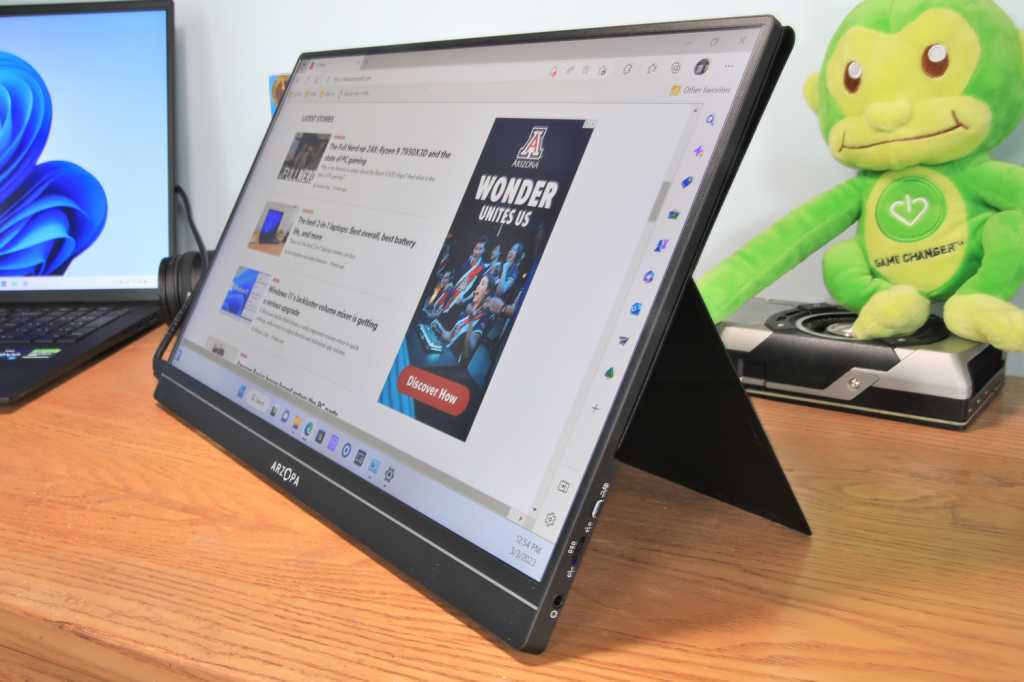Portable monitors have gained in popularity, and it’s easy to see why. They’re a boon to both desktop and laptop users. While portable monitors might not reach the large screen sizes of conventional displays, they offer other advantages: They are relatively inexpensive, easy to connect, and, best of all, easy to transport — whether that’s to a different city for work, or to a different room in your house.
But the widespread availability of these displays and the ability to manufacture them cheaply has resulted in some questionable brands on the market. Often the quality of these monitors can be sub-par. That’s where we at PCWorld come in. We’ve tested multiple models and can separate the best portable monitors from the rest.
Our list of favorites below will help you find the right portable monitor for you. You can learn more about what to look for in a portable monitor at the bottom of the article.
Arzopa Z1FC – Best budget portable monitor
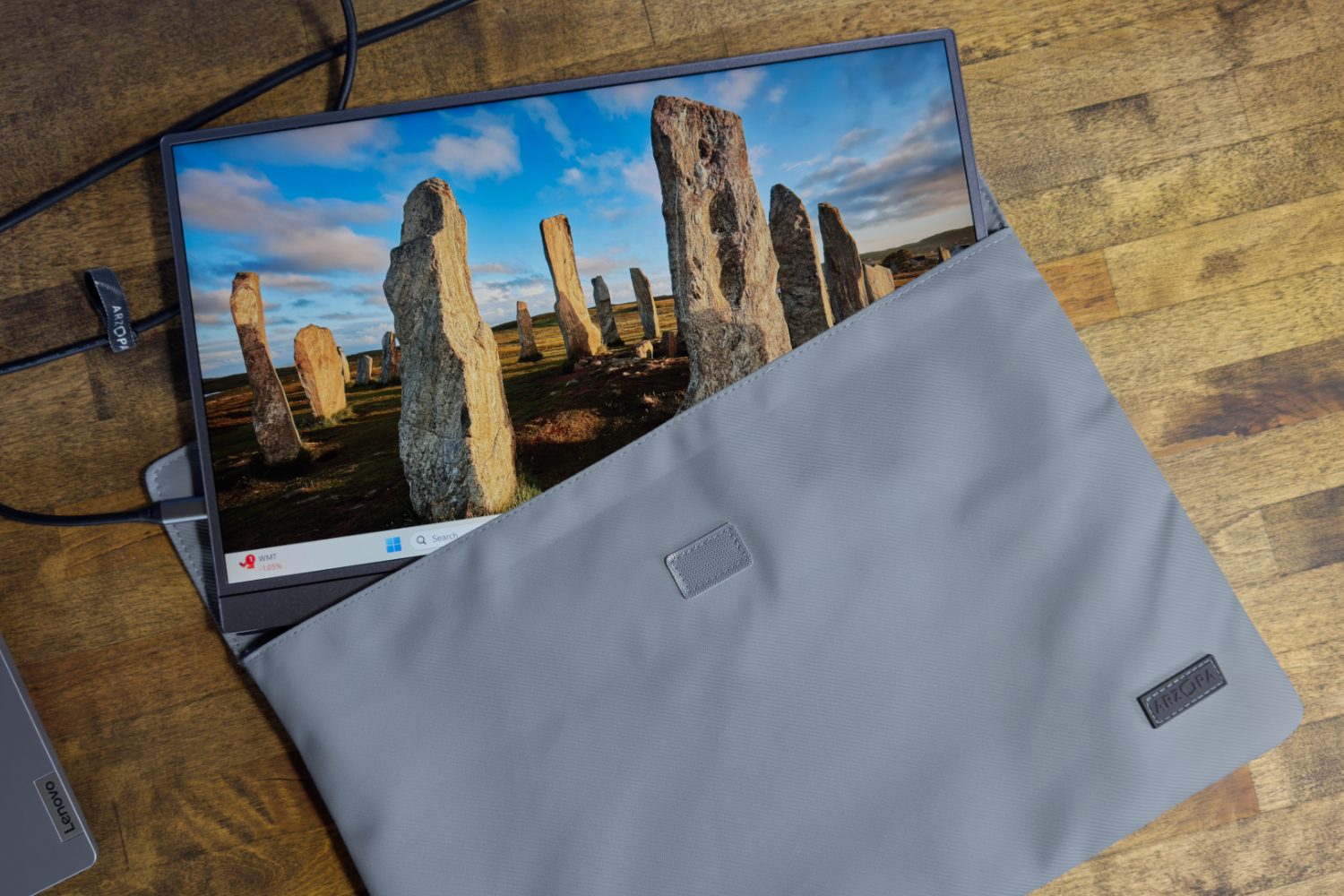
Pros
- Good build quality for the price
- Integrated kickstand minimizes thickness
- Bright display with respectable image quality
- 144Hz refresh rate provides good motion clarity
Cons
- HDMI port is not full-sized
- HDR input is technically supported, but it’s not great
- Doesn’t support Adaptive Sync
Price When Reviewed:
$169.99
Best Prices Today:
Who should buy the Arzopa Z1FC?
The Arzopa Z1FC is great for budget-conscious users who need a versatile portable monitor for productivity and casual gaming.
Priced at between $170 and $200 (with carrying case, or about $100 without), it delivers an attractive aluminum back panel with integrated kickstand. It’s also portable at just 1.7 pounds and 0.3 inches thick. The monitor’s 144Hz refresh rate and bright 337-nit display make it notably better than many budget competitors.
The monitor’s dual USB-C ports with power delivery also make it convenient if you have a laptop with USB-C out and want a simple, plug-and-play setup that requires a single cable. It ships alongside a carrying case with dual pockets that has room for the monitor, a slim laptop, and a USB-C cable.
Arzopa Z1FC: Further considerations
While it’s good for the price, the Z1FC has some notable limitations. It lacks Adaptive Sync, so games won’t look as smooth as on monitors with it. The slim profile also requires the use of a mini-HDMI port, which is less common than full-sized HDMI.
If you can spend about $30 to $50 more, you might be happier with budget OLED portable monitors such as the Innocn 15A1F below. The 15A1F is just a little more expensive yet offers dramatically better contrast and color performance. It only has a 60Hz refresh rate, though, so it’s not ideal for fast-paced games.
Read our full
Arzopa Z1FC review
InnoView Portable Monitor – Best portable monitor under $100
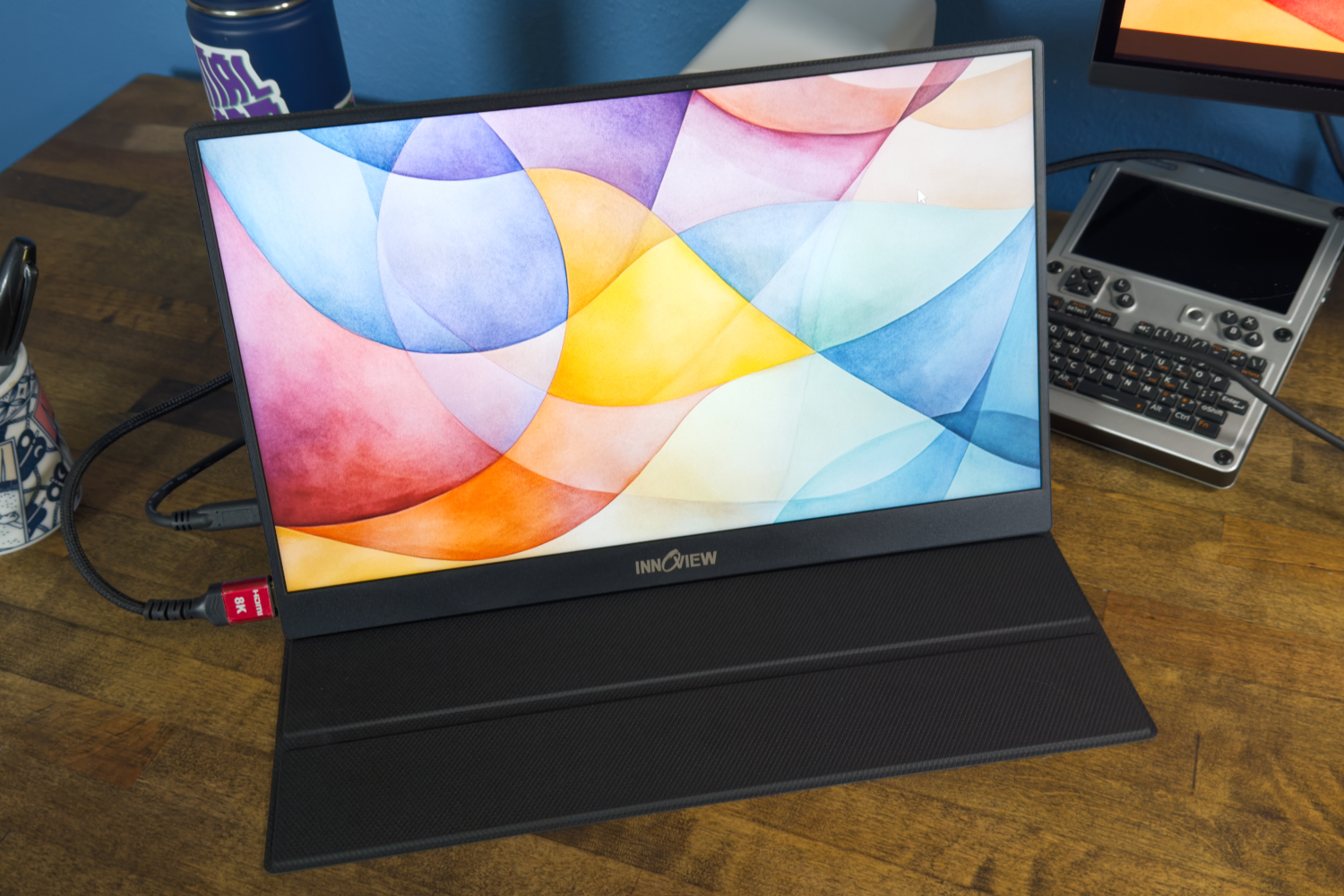
Pros
- Good brightness and clarity
- Surprisingly acceptable speakers
- Both USB-C and full-size HDMI connectivity
- Extremely affordable
Cons
- Budget build quality
- Awkward stand
- Muted, dull color performance
Price When Reviewed:
$89.99
Who should buy the InnoView Portable Monitor?
The InnoView Portable Monitor is a good choice if you want an entry-level portable monitor at the lowest price possible.
The 15.6 inch display has a sharp 1080p panel that’s ideal for light office work, web browsing, and other less demanding tasks. It offers an appealing blend blend of solid image quality, versatile connectivity, and acceptable built-in speakers.
Its accessible price point—sometimes as low as $60 to $80–makes it a worthy option for students and travelers looking for a basic but functional second screen experience.
InnoView Portable Monitor: Further considerations
While the InnoView Portable Monitor is a good value, its budget price requires a few trade-offs. The included kickstand case looks basic and has limited tilt adjustment. The monitor’s color performance is sub-par, too, so it’s not a great pick for photo and video editing (or other creative tasks).
Read our full
InnoView Portable Monitor review
Innocn 15A1F – Best midrange portable monitor
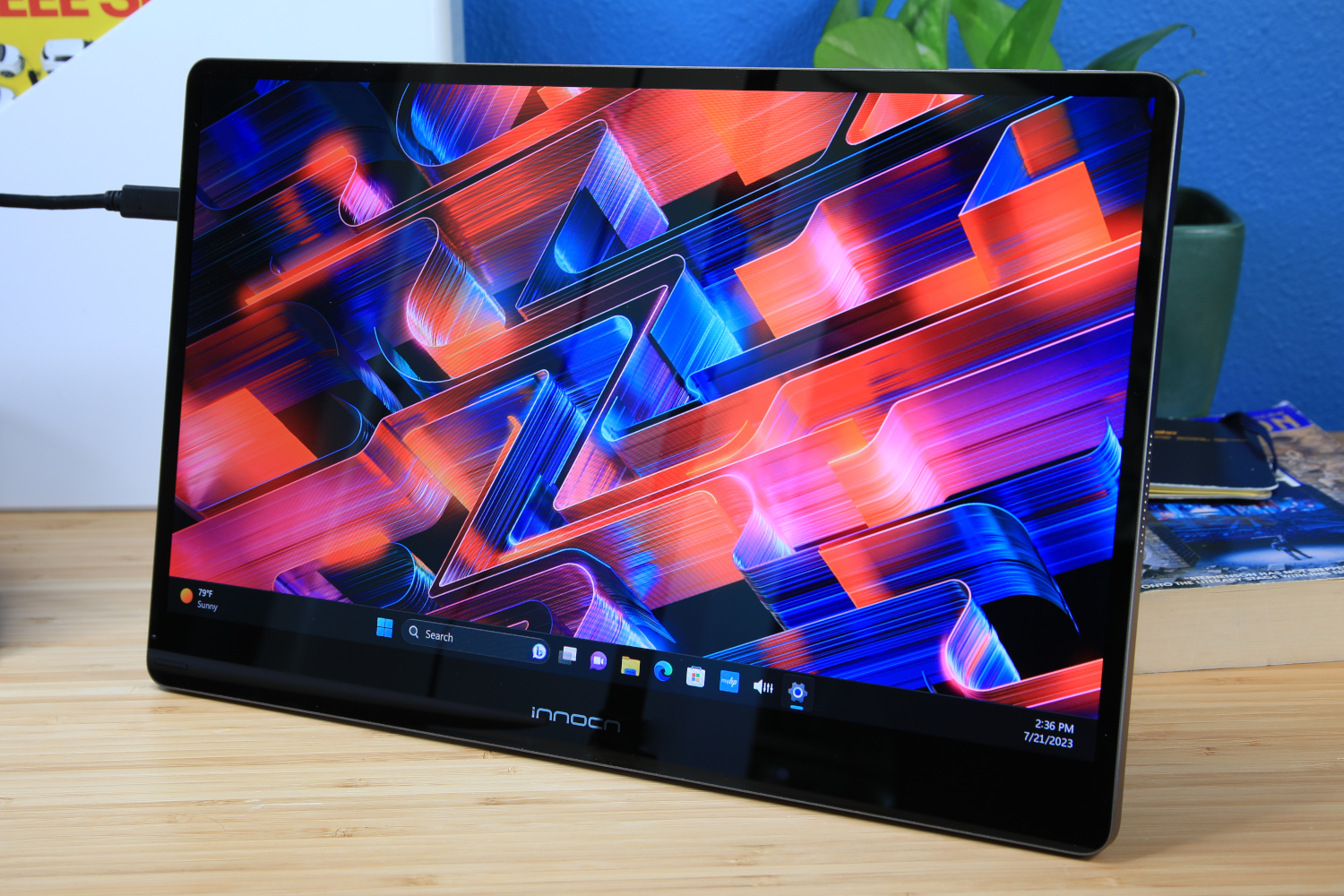
Pros
- Excellent image quality
- Durable and attractive design
- Versatile clip-on stand
- Unbeatable bang-for-the-buck
Cons
- Doesn’t include a protective case
- HDR is supported but disappointing
Price When Reviewed:
319.99
Best Prices Today:
Who should buy the Innocn 15A1F?
The Innocn 15A1F is for users who want excellent image quality and attractive design at an affordable price point.
The 15A1F has a 15.6-inch OLED panel with a resolution of 1920×1080 and a 60Hz refresh rate. Its design, reminiscent of the Apple iPad Pro, elegantly combines an aluminum rear panel with edge-to-edge glass. The monitor’s 60Hz refresh rate might be a limitation for gamers, however.
Image quality is where this portable monitor stands out. It delivers a maximum brightness of 378 nits and achieves an infinite contrast ratio. This combination provides a bright, vivid, and immersive image. It also delivers an impressive 100 percent of the DCI-P3 color gamut and 94 percent of AdobeRGB. That’s more than adequate for photo and video editing.
Innocn 15A1F: Further considerations
The 15A1F has a unique, versatile clip-on stand that adds stability and a wide range of tilt adjustments. Innocn doesn’t include a protective case, however, so shoppers should consider a third-party protective sleeve.
Priced at an MSRP of $349.99, which often drops to a tempting $199.99 on Amazon, the Innocn 15A1F is an excellent choice if you want a portable monitor with top-tier image quality on a budget.
Read our full
Innocn 15A1F review
Viewsonic VX1655-4K-OLED – Best 4K portable monitor
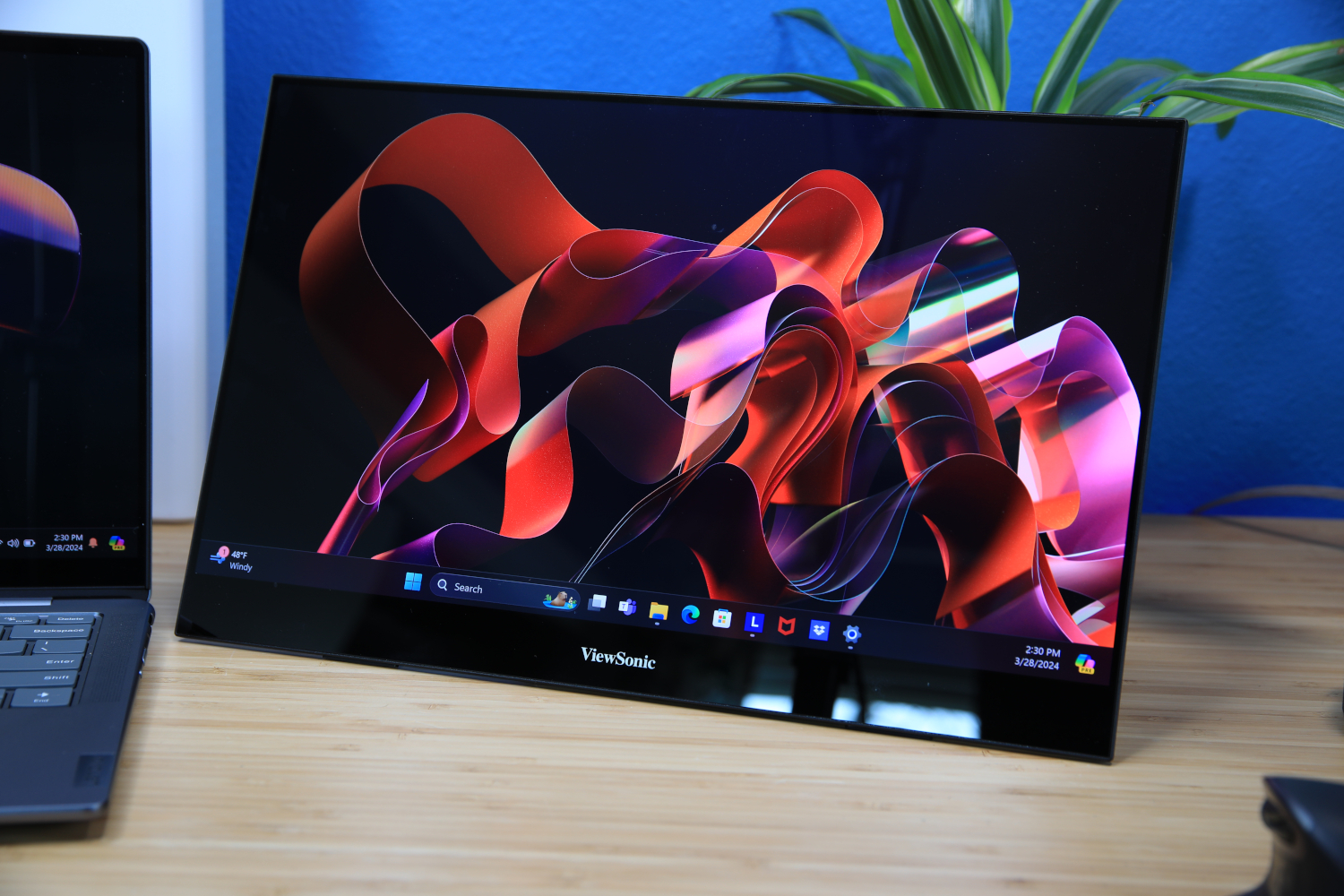
Pros
- Excellent image quality
- Useful built-in kickstand
- Attractive and sturdy design
- Extensive image-quality options
Cons
- Flimsy bundled keyboard cover
- Some on-screen menu options are confusing
- Power adapter could be smaller
Price When Reviewed:
$499.99
Best Prices Today:
Who should buy the Viewsonic VX1655-4K-OLED?
The Viewsonic VX1655-4K-OLED is a good choice for creators who prioritize 4K resolution and exceptional image quality in a form factor that’s conducive to transport for work in remote environments.
The VX1655-4K-OLED delivers exceptional sharpness, color accuracy, and contrast. Its brightness peaks at an impressive 457 nits, which is beneficial for working in brightly lit environments. Its comprehensive color gamut is suitable for color-critical work such as photography, design, and video editing. It also has a native resolution of 3840×2160 (4K), which makes it ideal for working with 4K video, as well as other high-resolution video and image files.
Viewsonic VX1655-4K-OLED: Further considerations
Design is another key strength of the VX1655-4K-OLED. It has a built-in kickstand, slim bezels, and a sturdy chassis, all of which make it easy to set up, and stable when in use. The monitor’s connectivity options, which include two USB-C ports and a mini-HDMI port, offer flexibility. However, the inclusion of a full-sized HDMI port would have been preferable.
While the monitor does have minor drawbacks, like a flimsy bundled display cover and confusing on-screen menus, these issues are overshadowed by its overall performance and build quality. Its premium price point reflects its position as a high-end choice for professionals, and its image quality is the best of any portable monitor we’ve tested to date.
Read our full
Viewsonic VX1655-4K-OLED review
Asus ZenScreen MB27ACF – Best 27-inch portable monitor
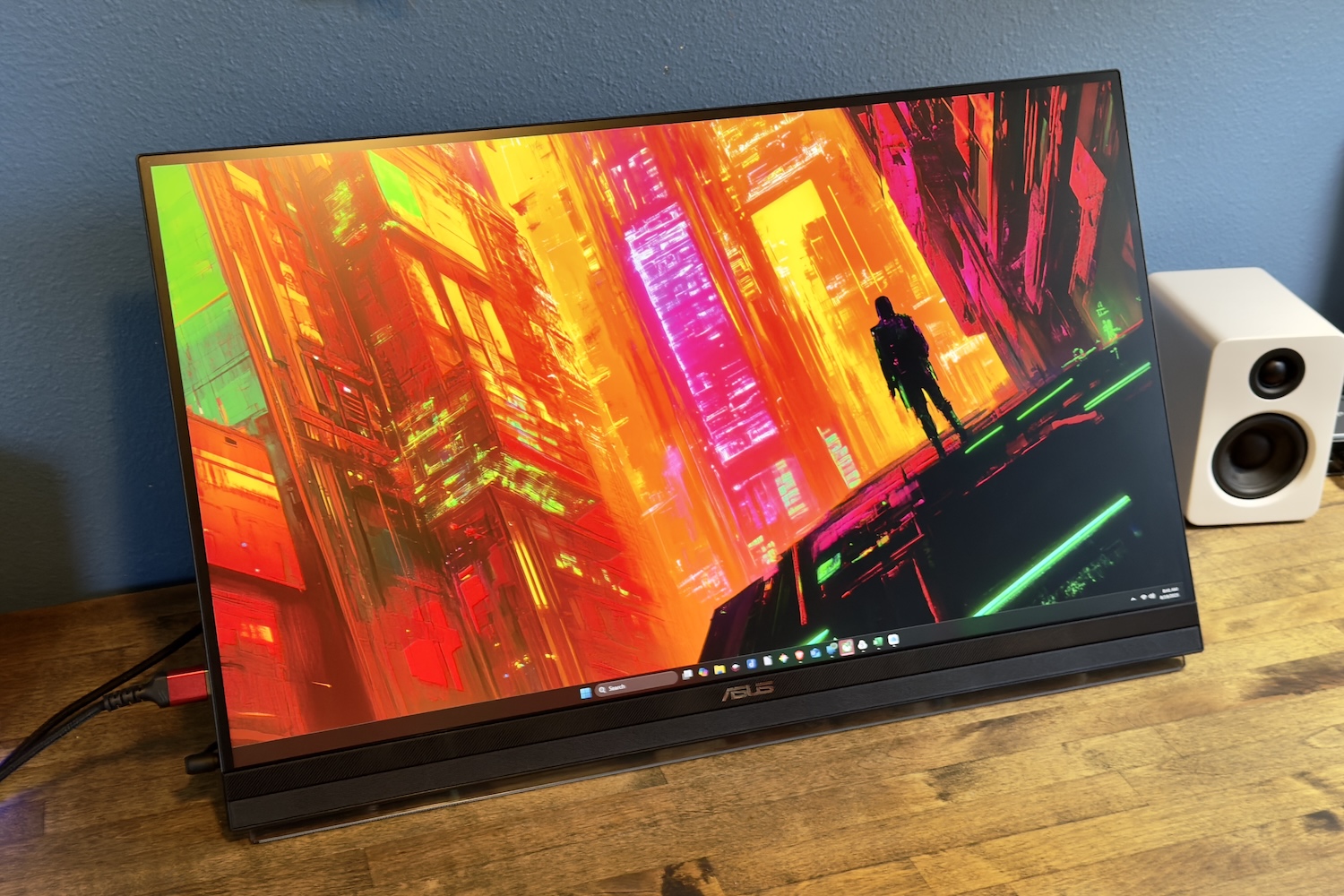
Pros
- Portable design with 27-inch display
- USB-C with 70 watts of Power Delivery
- Includes C-clamp desk stand and cubicle mount
- Decent audio quality from 2.1-channel sound system
Cons
- Limited connectivity
- Low contrast ratio
- Modest color performance
- Expensive for a 27-inch 1440p display panel
Price When Reviewed:
$465.99
Best Prices Today:
Who should buy the Asus ZenScreen MB27ACF?
The Asus ZenScreen MB27ACF is an unusually large portable monitor designed for professionals who need a large, portable display they can move between meeting rooms, offices, or shared workspaces.
It has a 27-inch display that’s several times larger than many other portable monitors. A large display means more room to present, collaborate, or work across multiple windows than smaller portable monitors. Yet slim profile, lightweight design, and built-in kickstand make it easy to reposition, while the included C-clamp stand and cubicle mounting brackets add flexibility for desk setups.
USB-C connectivity with 70 watts of power delivery also makes it convenient for laptop users, particularly those with MacBooks or modern Windows ultrabooks that can run on a single cable. The built-in speakers, while modest, are good enough for calls or quick presentations, which should be handy both in a cubicle and in a conference room.
Asus ZenScreen MB27ACF: Further considerations
The MB27ACF is priced at $449 MSRP, which is steep for a 27-inch 1440p IPS monitor—especially when you can buy a 4K desktop monitor with better image quality at a similar price.
Connectivity is an issue as well, as the monitor only has USB-C and HDMI. That may be restrictive if you plan to keep it on a desk full time, and all the ports are side-mounted, which can look cluttered.
In short, the MB27ACF is best for people who want a big, versatile, portable monitor, and aren’t too concerned about resolution of image quality.
Read our full
Asus ZenScreen MB27ACF review
Other portable monitor reviews
The Viewsonic VA1655 has USB-C power with 60 watts of power delivery and the ability to charge a connected laptop, but its thicker form-factor and mediocre image quality dampen its appeal; Viewsonic TD1656-2K is a portable touchscreen monitor with a sharp image and included passive stylus, but it’s better in Excel than your favorite photo editor; its sibling the ViewSonic VG1656N offers some neat features for a portable monitor, such as its easy wireless connectivity, its flexible orientation, and its affordability, but we’re not as enamored with its middling color performance.
How we test portable monitors
PCWorld’s monitor evaluations are conducted by supject-expert freelance and staff contributors with decades of collective experience. Although our initial impressions rely on our eyes, we rigorously test each monitor using a Datacolor Spyder X2 Ultra color calibration tool for a comprehensive analysis.
This device helps us objectively measure a variety of monitor attributes including brightness, contrast, color gamut, color accuracy, luminance and color uniformity, and gamma, among other traits.
We also rely on hands-on testing to judge the quality, size, and weight of a portable monitor. Every monitor we recommend is personally tested first-hand by a PCWorld contributor. This helps us pick out flaws in build quality and portability that separate the best and worst portable monitors.
To learn more about our monitor evaluation process see our article on how we test monitors at PCWorld.
Why you should trust us
PCWorld prides itself on its decades of PC hardware experience and expertise. We’ve been covering PCs since 1983, and we now review dozens of monitors every year. All of our recommendations have been personally tested and vetted by our expert reviewers, who’ve applied not only performance benchmarks but rigorous usability standards.
Who curated this article?
Matthew S. Smith is a freelance technology journalist with 15 years of experience reviewing consumer electronics, including the broad spectrum of computer monitors. In addition to PCWorld, his work can be found on Wired, Digital Trends, Reviewed, Lifewire, and other technology publications.
How to choose the best portable monitor
Many of the features we look for in a desktop monitor also apply to a portable monitor. A portable monitor should have a bright, sharp image with a decent contrast ratio, wide color gamut, and great color accuracy. The differences between portable monitors and their desktop brethren are more often found in their design, build quality, and connectivity.
Image quality
Most portable monitors have image quality similar to desktop monitors in the same price bracket. Portable monitors tend to score well in brightness and sharpness, but color and contrast are often lacking. OLED portable monitors perform significantly better than less expensive IPS LCD displays. Unfortunately, they’re much more expensive.
Numerous small brands have jumped into the portable monitor market in recent years and quality control can be an issue. We recommend sticking to monitors that are known to achieve high marks in image quality (otherwise, be prepared to use a retailer’s return policy).
Stands, kickstands, and covers
Portable monitors ship with a bundled kickstand or stand that is used to keep the monitor propped up and steady on a desk.
Unlike desktop monitors, where most stands are more or less identical, the stands used by portable monitors vary. Some have a simple kickstand that attaches magnetically, while others use a clip-on case. A rare few, like the Viewsonic ColorPro VP16-OLED, have a folding stand that provides significant height and kickstand adjustment.
Connectivity
Connectivity is key. A portable monitor that lacks the port you need to connect your tablet or laptop is useless.
Most portable monitors offer the option to connect over USB, a video input (usually HDMI), or both, but the number of ports available and the standards used vary widely. We look for monitors that offer a healthy selection of ports. We also prefer monitors that can be powered over USB-C by a connected desktop or laptop.
Portability, size, and weight
Our final consideration is the most obvious: portability. Most portable monitors live up to their name with an included kickstand case or cover that can fold flat and protect the display while it’s stowed.
Still, the exact size and weight of a portable monitor is important, and shoppers may need to accept trade-offs between weight and quality. A top-notch pick like the Viewsonic ColorPro VP16-OLED can offer superior durability, but a lightweight budget pick like the Arzopa Z1FC Gamut might be preferable if you’ll be hauling a portable monitor daily.
FAQ
What is the best portable monitor?
The best portable monitor for most people is PCWorld’s midrange pick: the Innocn 15A1F, which is distinguished by image quality and features that belie its affordable price of around $200.
The 15A1F sports a 15.6-inch OLED panel with a resolution of 1920×1080 and a 60Hz, and has an elegant design, a unique clip-on stand that’s both versatile and stable, and the chops for top-notch photo and video editing. All in all, it’s a surprisingly luxurious package for the price.
What size of portable monitor is best?
Most portable monitors use a 13.3-inch or 15.6-inch panel, and those that don’t typically have a panel size close to one of those two standards (such as 13.1 or 16 inches).
A monitor with a 13.3-inch panel is great for frequent fliers and other travelers looking to pack light. A 13.3-inch model will typically weigh about a quarter- to half-pound less than a 15.6-inch model. The downside, of course, is a smaller display that can feel cramped, which can make a 13.3-inch display frustrating.
15.6-inch portable monitors are a better choice in many situations, as viewing the display for long periods of time will prove more comfortable. Though larger than a 13.3-inch model, 15.6-inch models remain small and will fit in most bags that fit a 14-inch laptop (or larger). 15.6-inch portable monitors are preferable for creators, too, as the larger display size makes it easier to view small details in videos, photos, and digital art.
What resolution is best for a portable monitor?
1080p is the most common resolution and is a great choice for nearly all situations. This resolution may seem unimpressive on paper, but the small size of a portable monitor increases the display’s pixel density. A 15.6-inch portable monitor with 1080p resolution looks nearly as sharp as a 27-inch monitor with 4K resolution.
What about 4K portable monitors? We don’t generally recommend them. Portable monitors with 4K resolution are less common, more expensive, and the improvement in sharpness won’t be perceptible to most people.
We also recommend that you avoid lower resolutions such as 720p and 1366×768. Though uncommon, portable monitors sold at very low prices (often below $100) sometimes have a native resolution below 1080p. This isn’t a great choice. Most modern apps, web pages, and content assume 1080p as a “standard” resolution and feel cramped at 720p or 1366×768.
What ports and connectivity should a portable monitor have?
We recommend buying a portable monitor that has a USB-C port with DisplayPort Alternate Mode and USB Power Delivery. The DisplayPort Alternate Mode turns the USB-C port into a video input, and USB Power Delivery can be used to power the portable monitor. This enables a single-cable connection between the portable monitor and a laptop, desktop, or tablet with USB-C.
An ideal portable monitor should pair USB-C with a backup video input, such as HDMI or DisplayPort, for connecting devices that lack USB-C. Most portable monitors offer this feature, but the HDMI or DisplayPort input is usually a smaller variant of the connection (like Micro-HDMI).
How much should a portable monitor cost?
Most portable monitors are inexpensive, but this is often reflected in their quality. We’ve noticed a wide range of build quality, design, and image quality among portable monitors that retail below $150. It’s possible to find a great portable monitor on a tight budget, but we recommend sticking to models tested by a professional reviewer.
A handful of portable monitors, such as the Viewsonic ColorPro VP16-OLED, are priced above $300. These rare models back up their price with special features such as a top-notch OLED panel or built-in battery. Paying extra for a quality monitor is worthwhile, but it’s not a requirement. Budget portable monitors like the Arzopa A1 Gamut look great and are well-suited to day-to-day productivity and web browsing.
Should I buy a portable monitor with HDR?
We don’t recommend portable monitors for HDR. While some manufacturers claim HDR support, the truth is that current portable monitors lack the brightness required to make HDR look its best. A portable monitor that claims HDR support will display HDR content, but it won’t look superior to SDR.
What battery life should I expect from a portable monitor?
You might be surprised to hear most portable monitors don’t include a battery and must be powered by an external source. In most cases, power is delivered over USB-C (or, in older models, USB-A) from a connected laptop, tablet, or desktop. You can also use an external power brick.
A few portable monitors include a battery, but we recommend you avoid these models. They’re considerably more expensive than portable monitors that rely on external power. The battery also adds weight and bulk. It’s often less expensive to buy an external battery pack to connect to the portable monitor.


